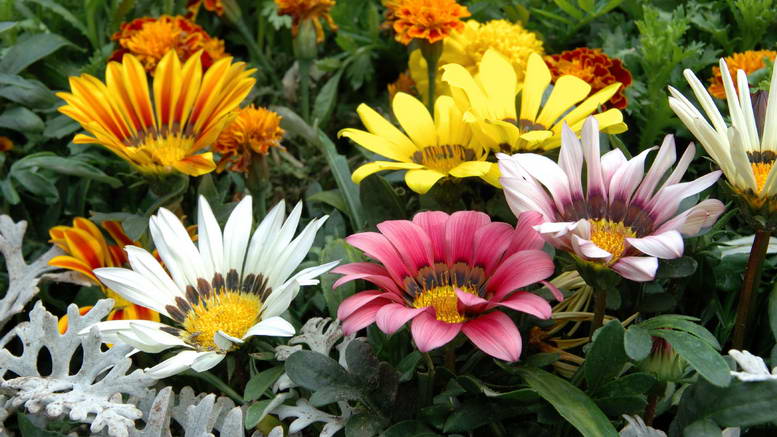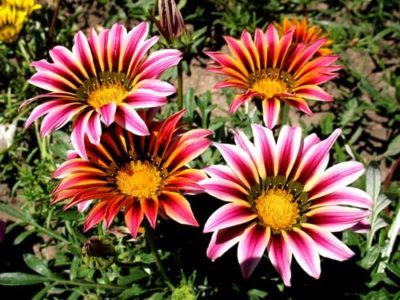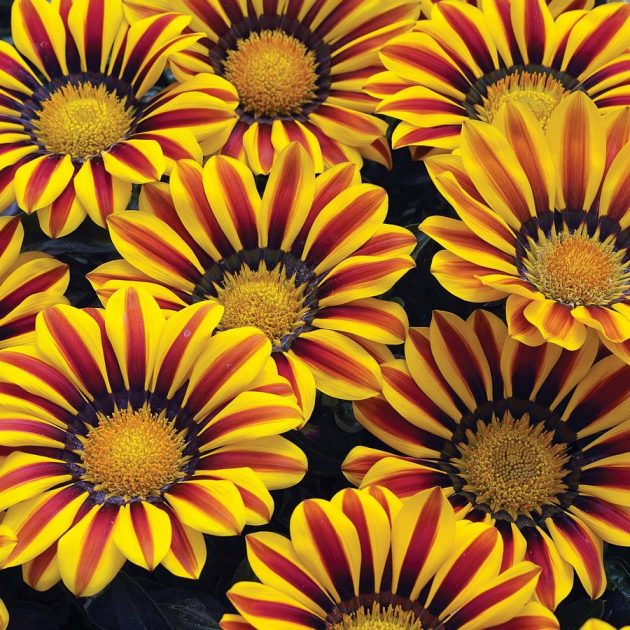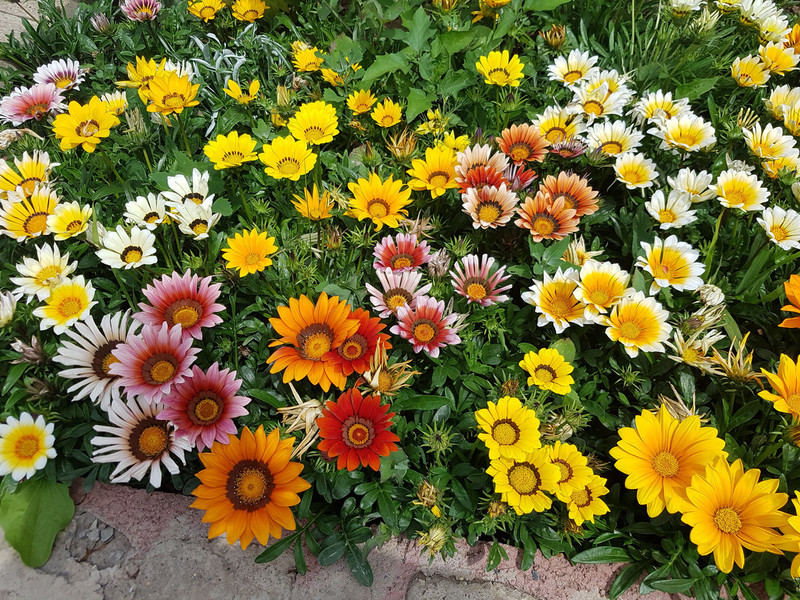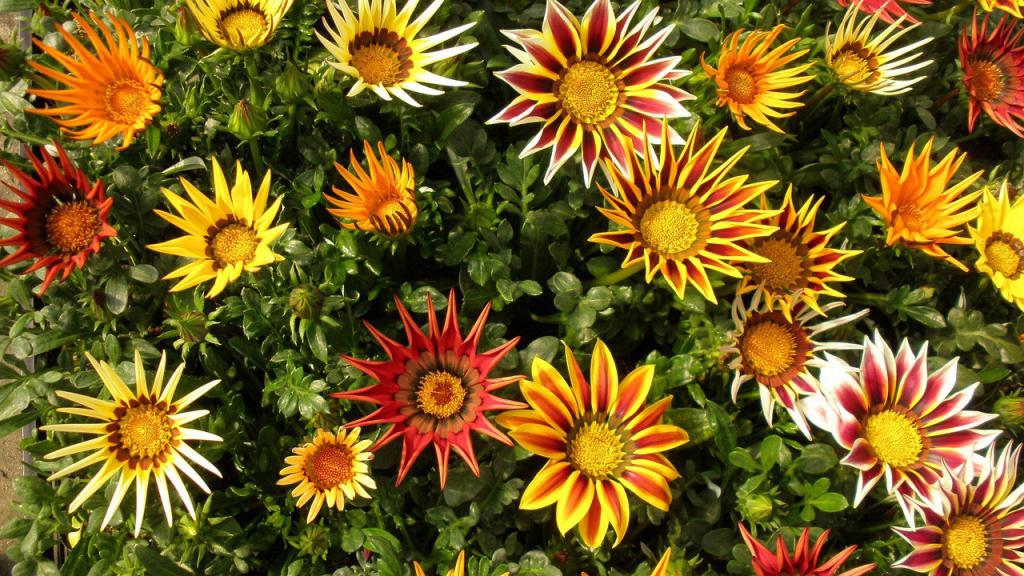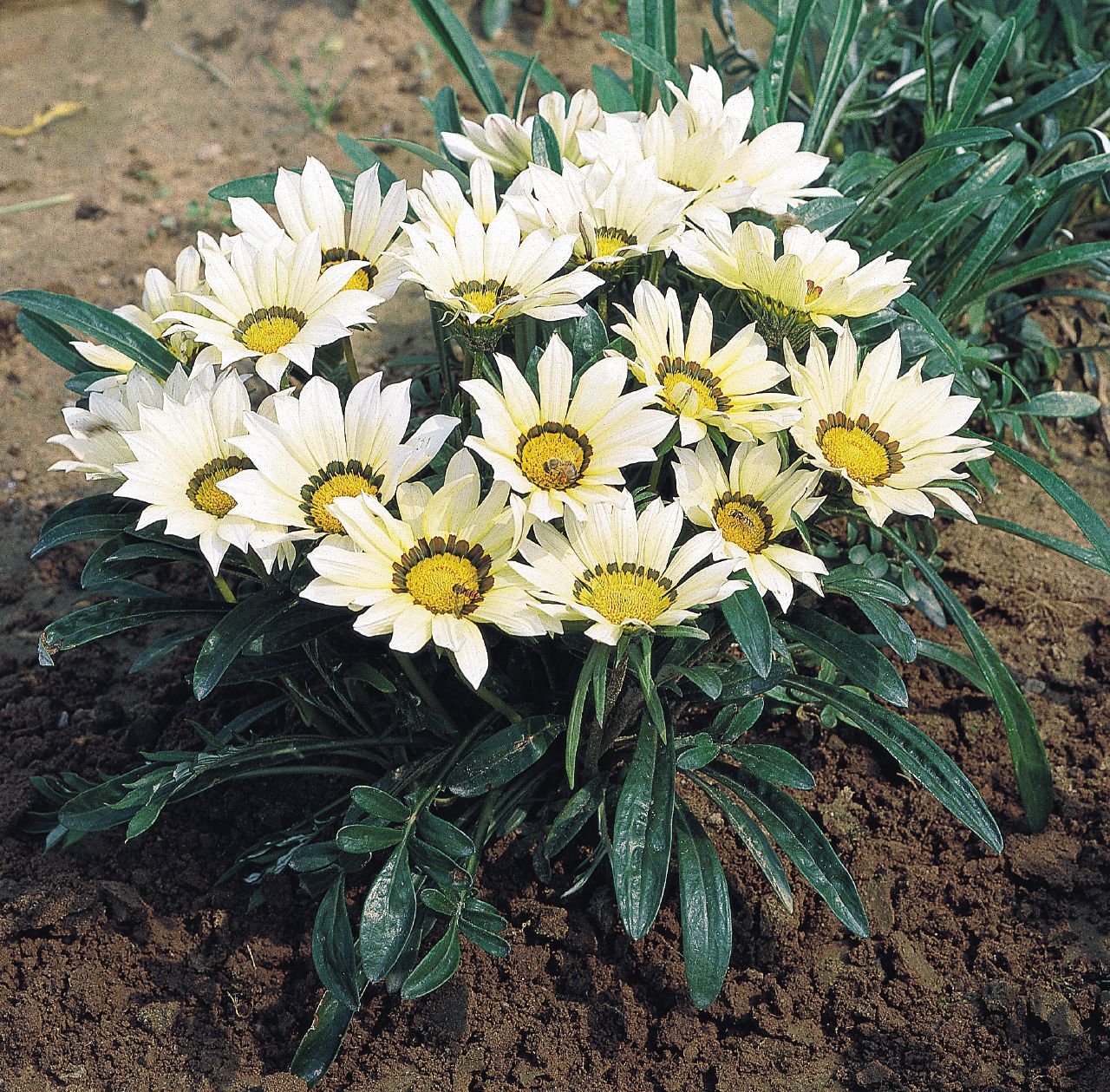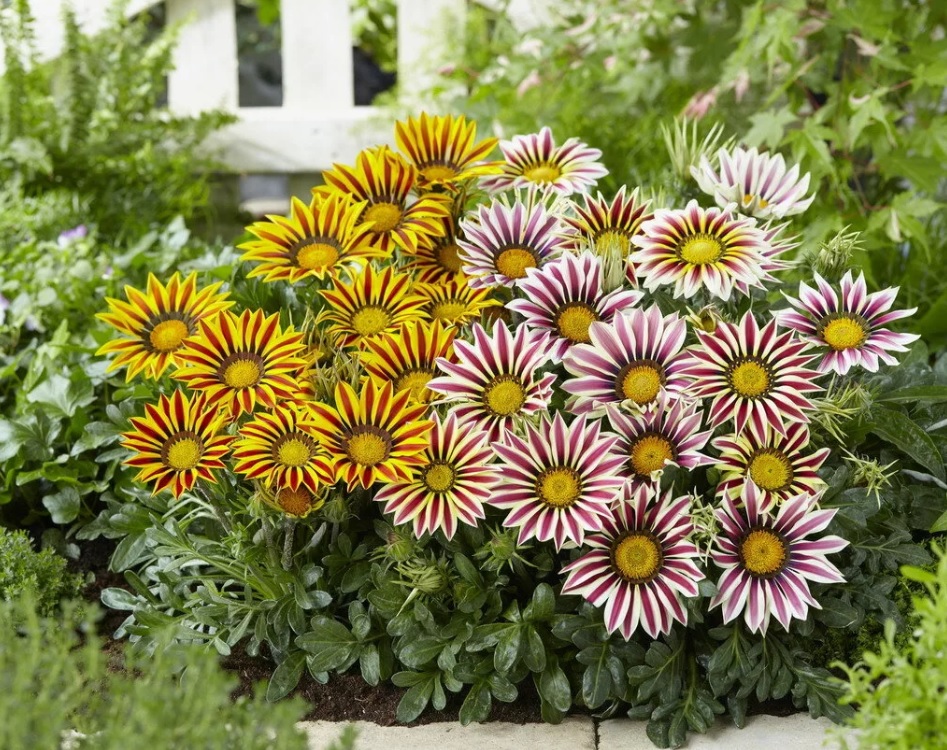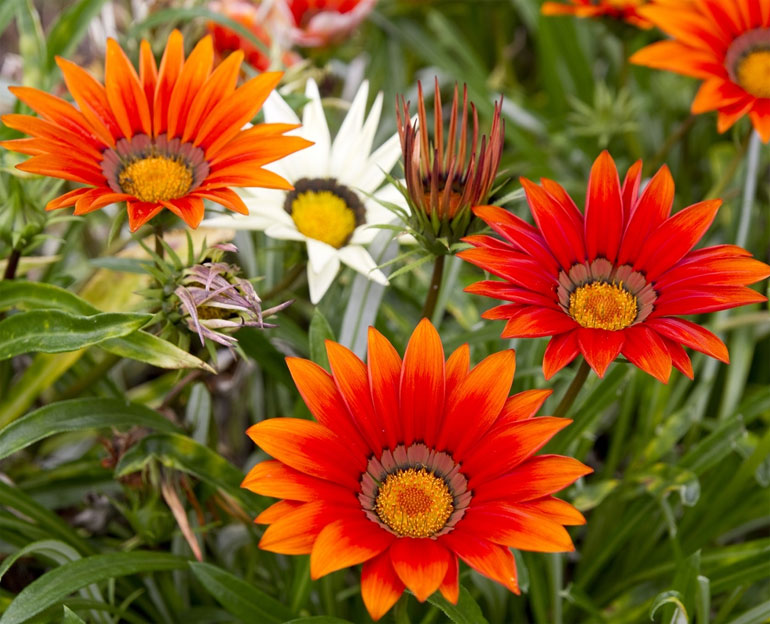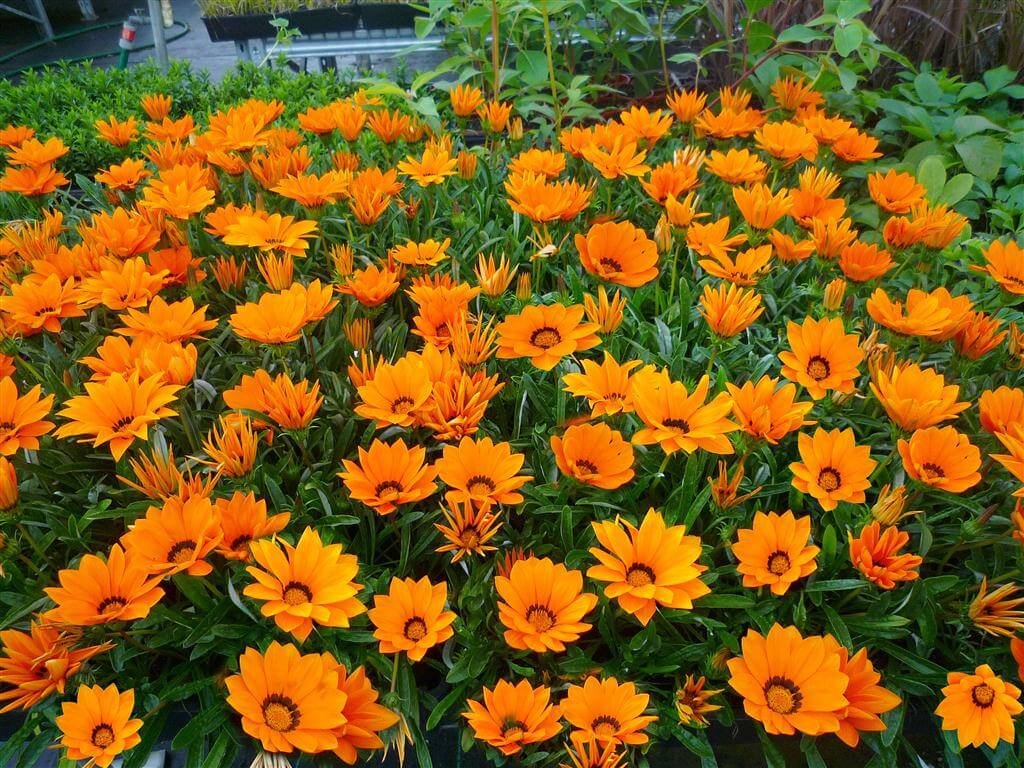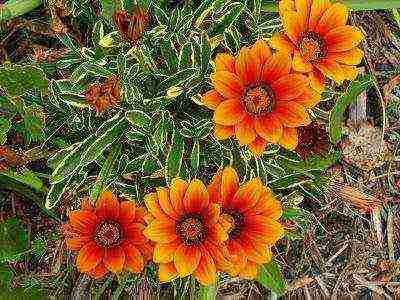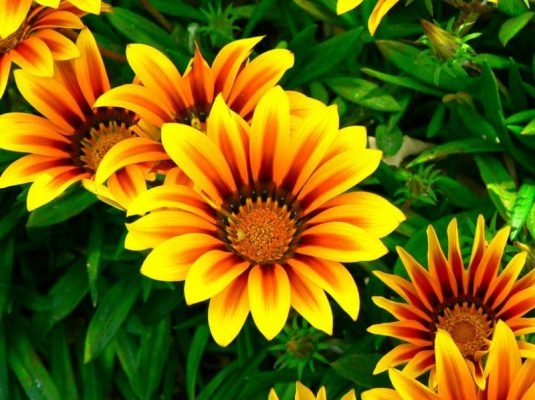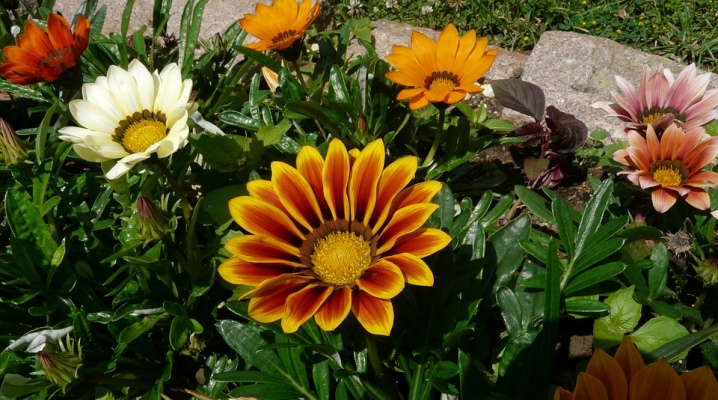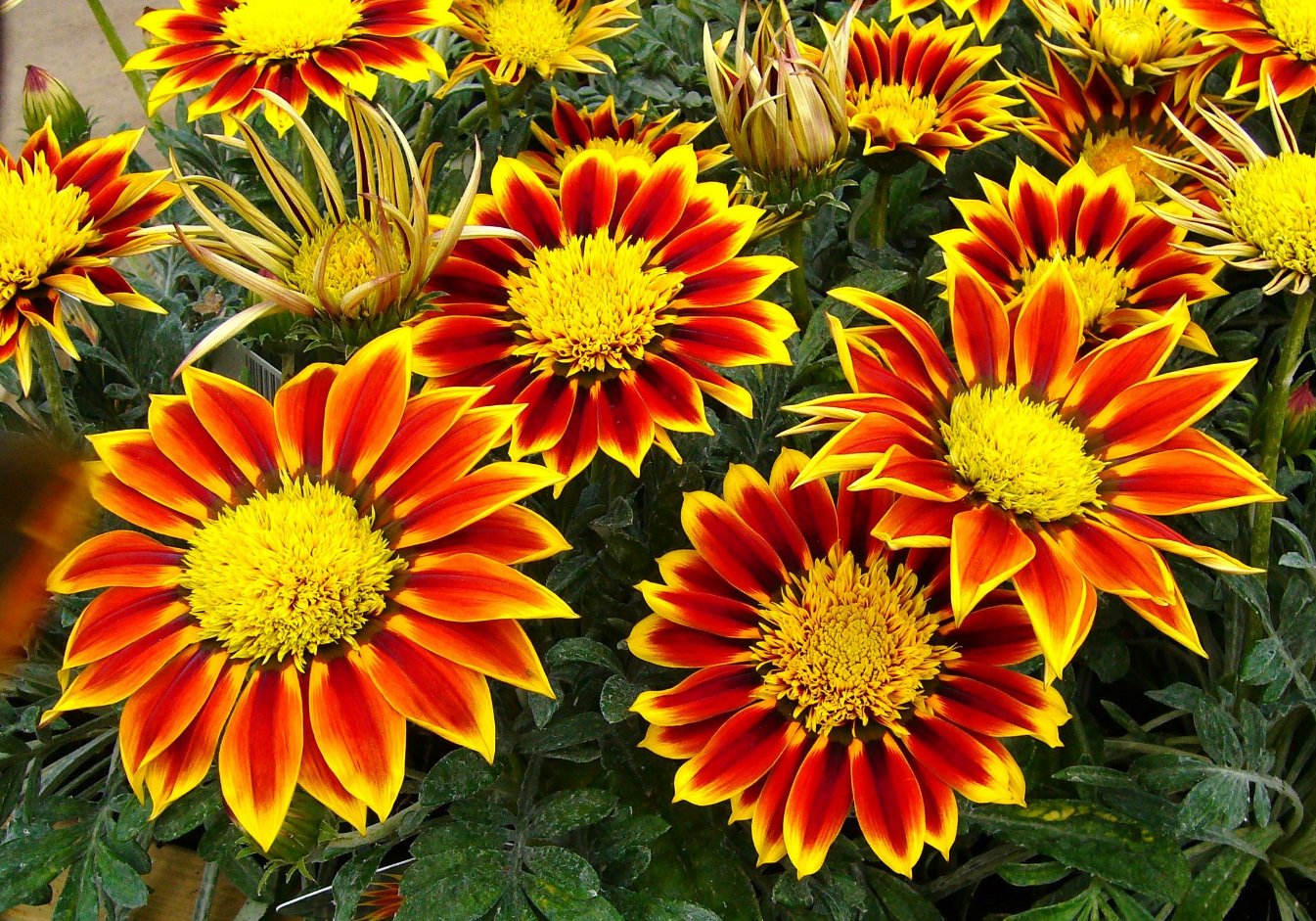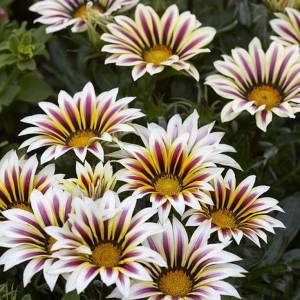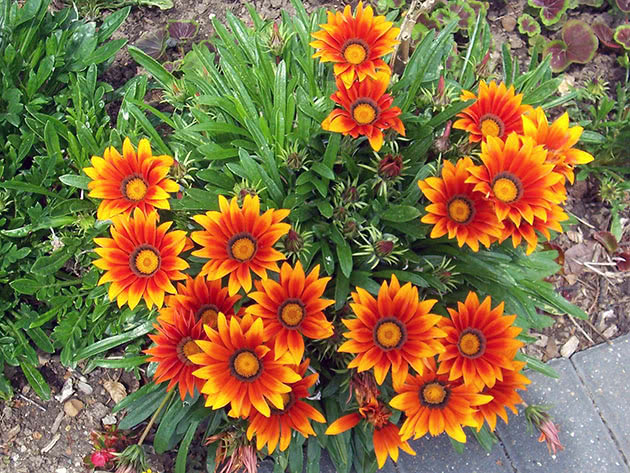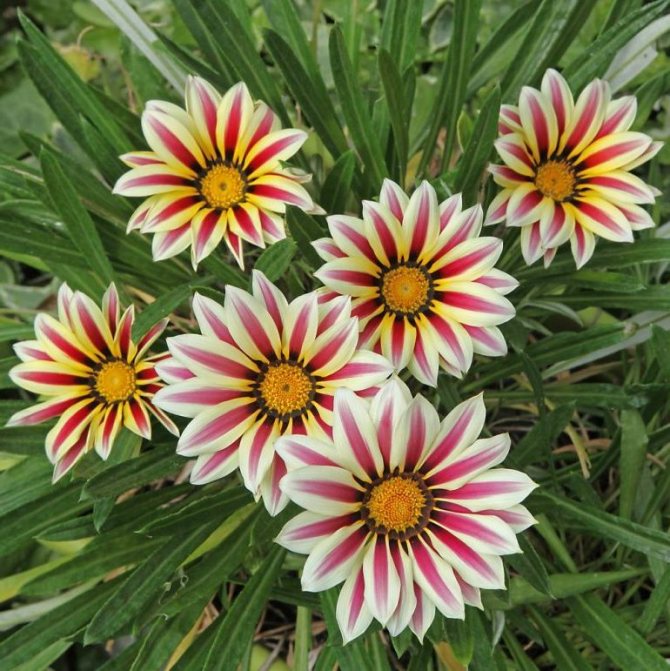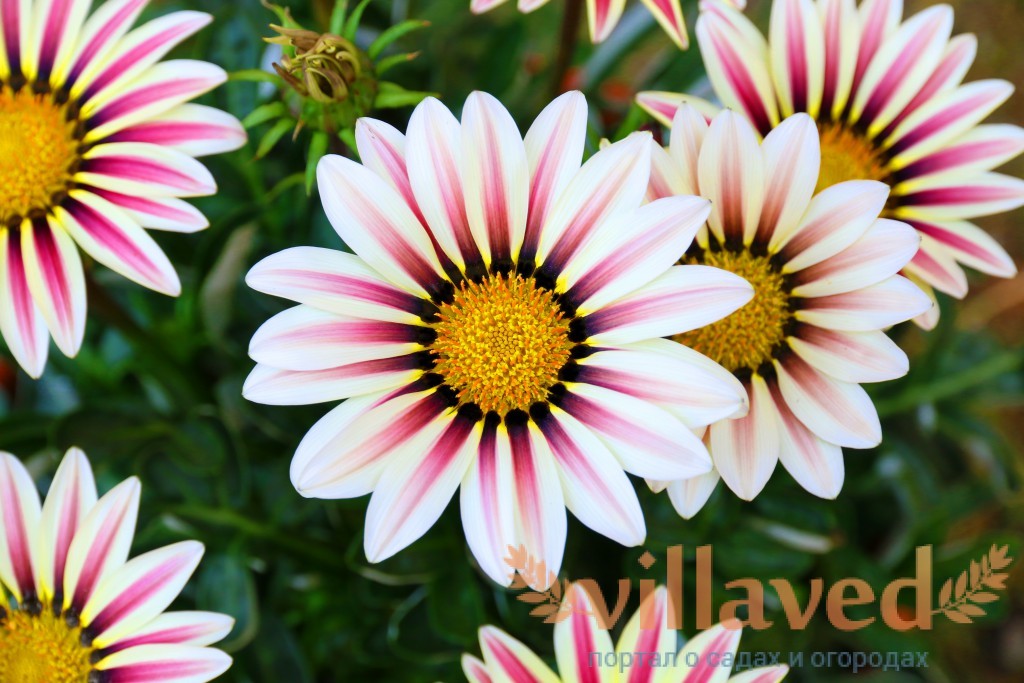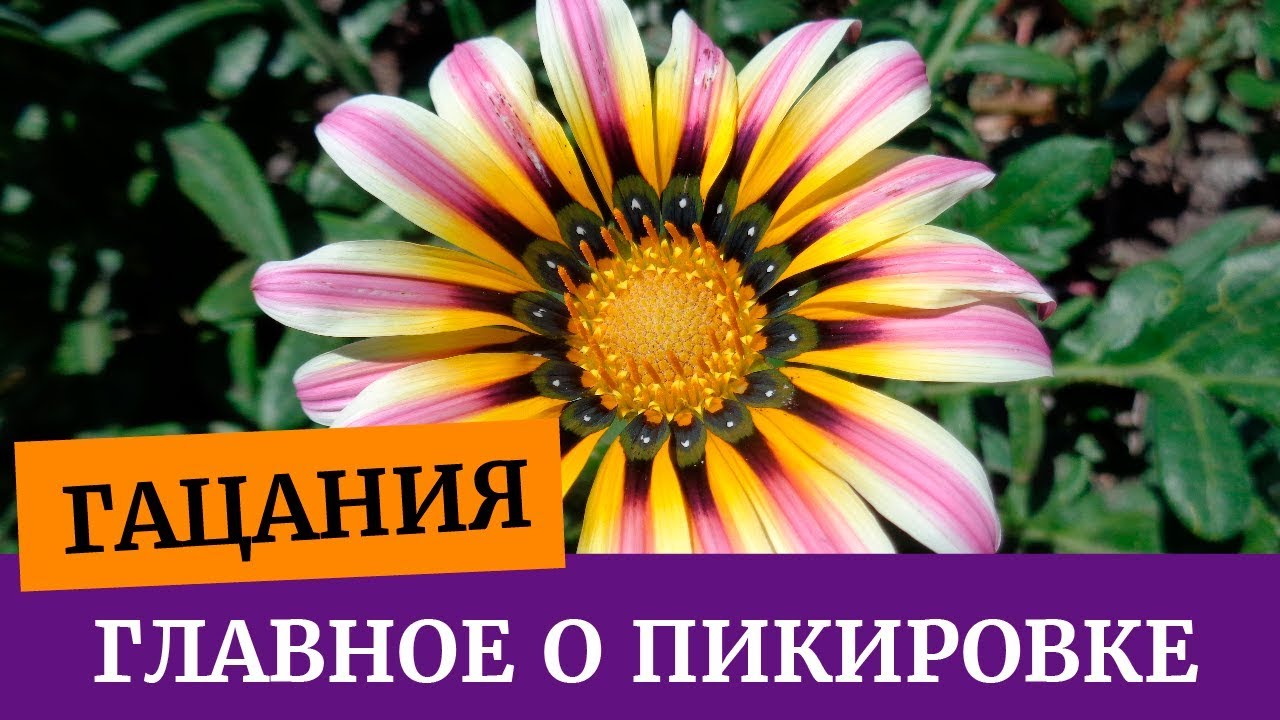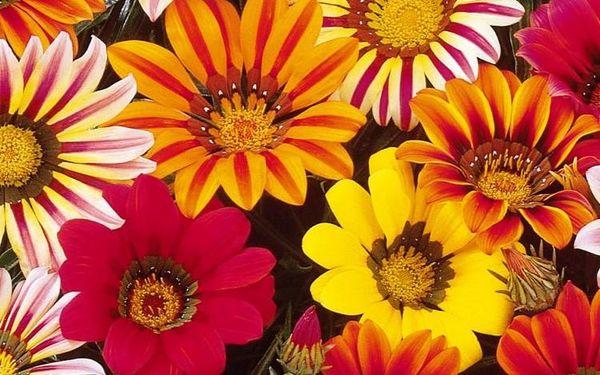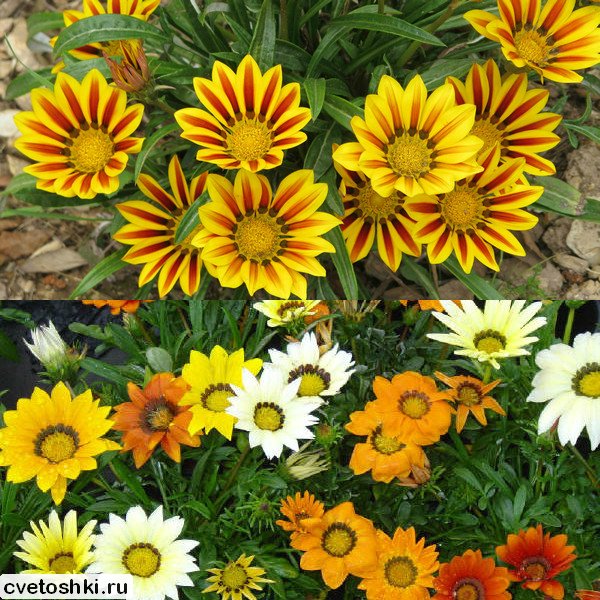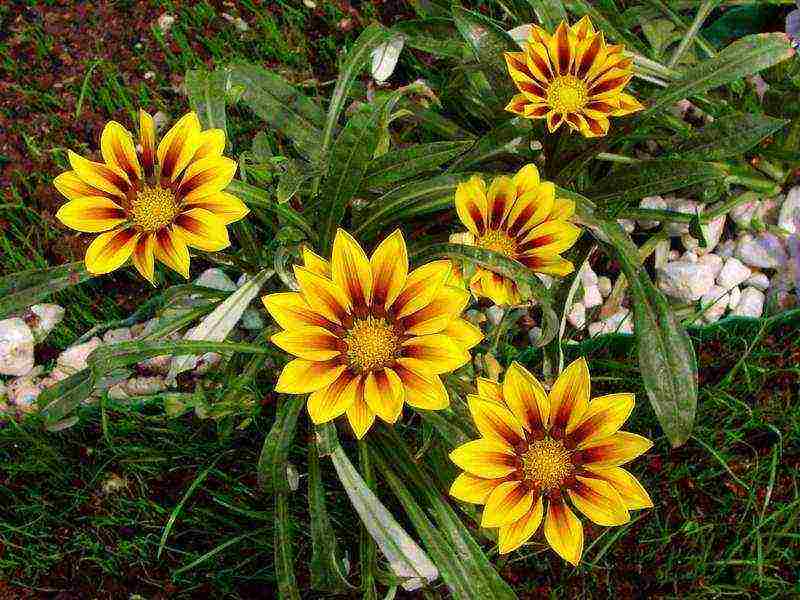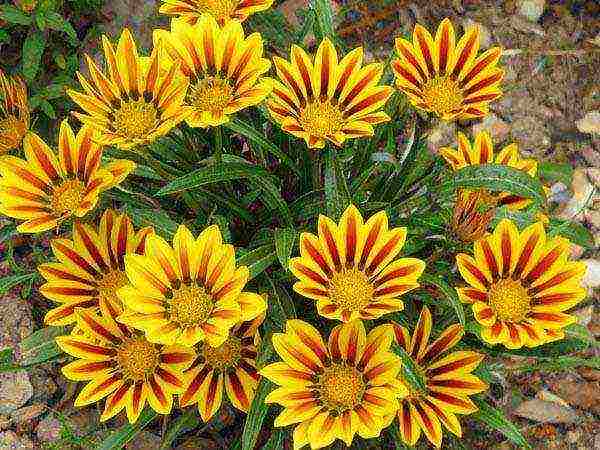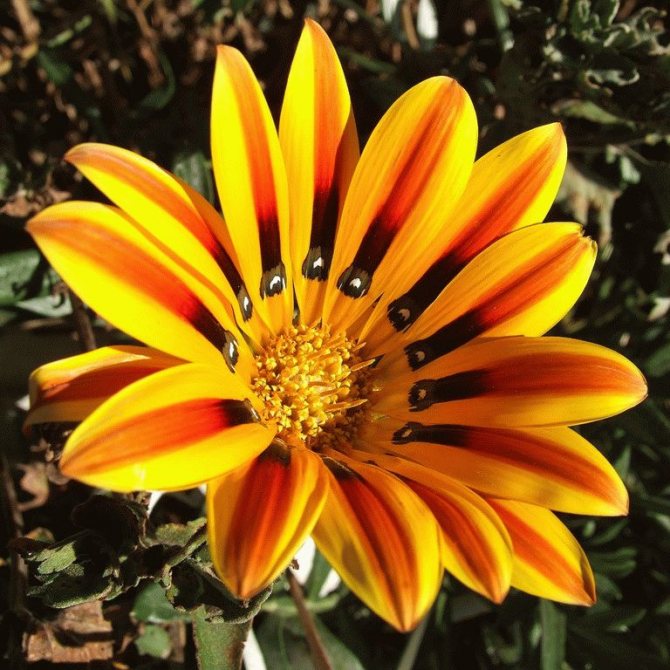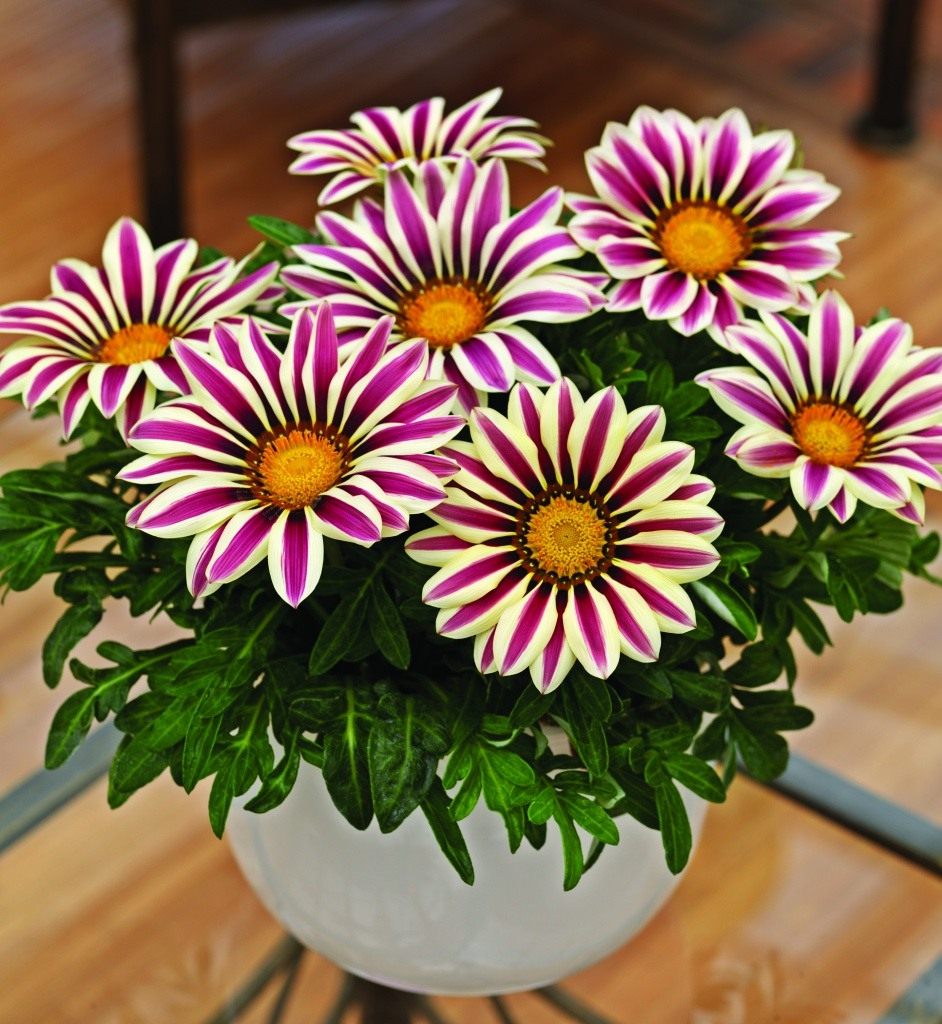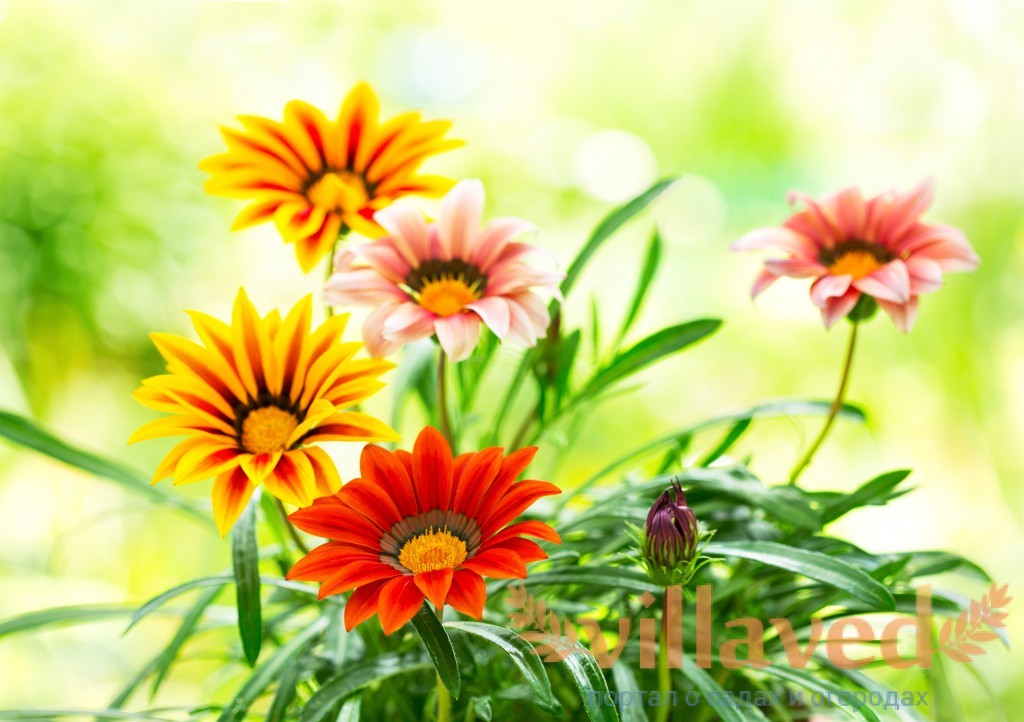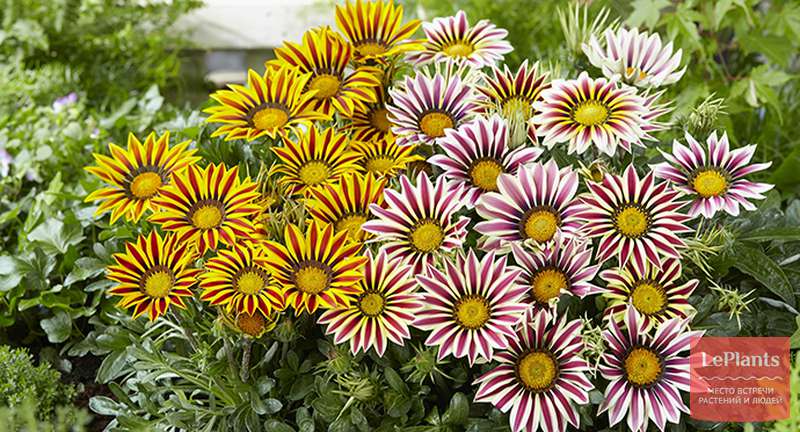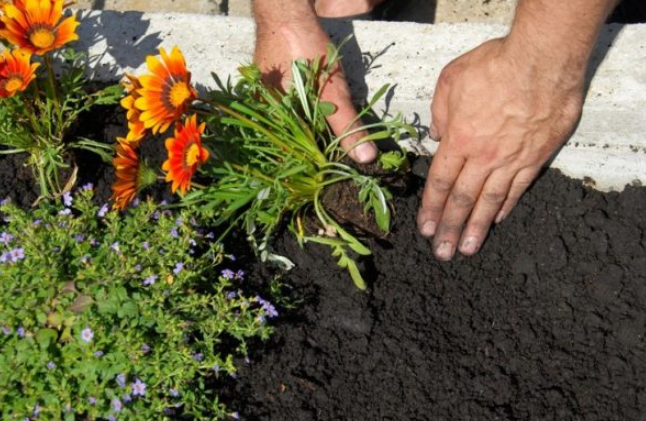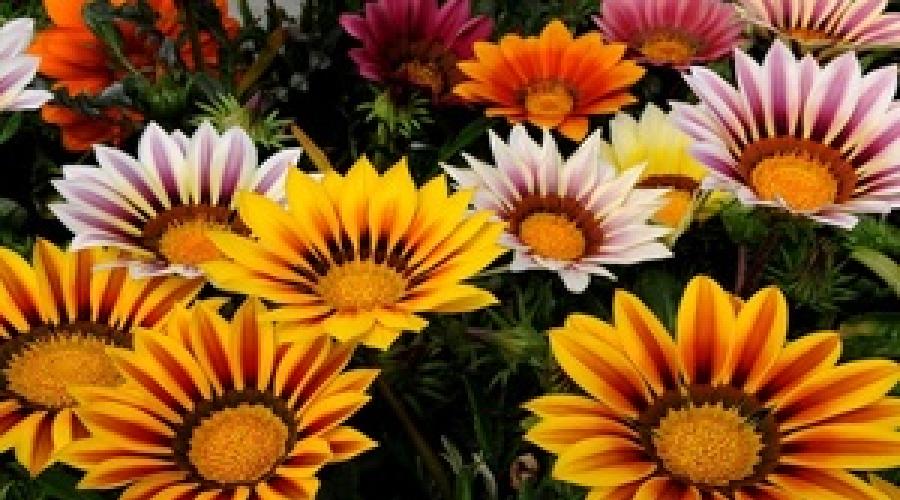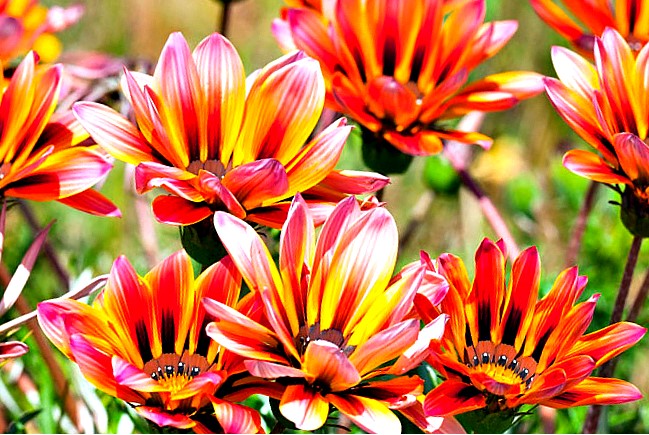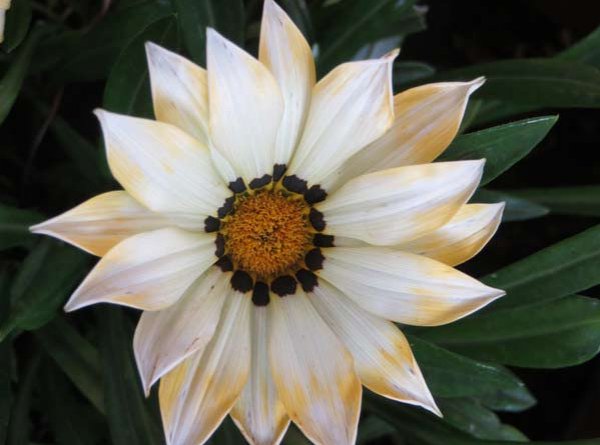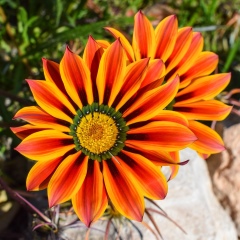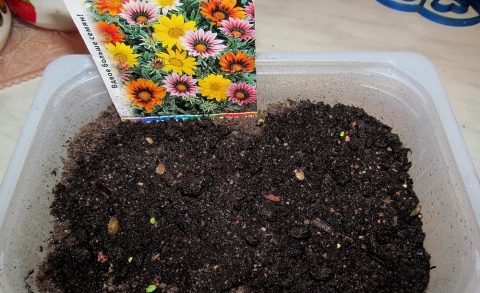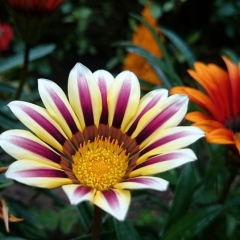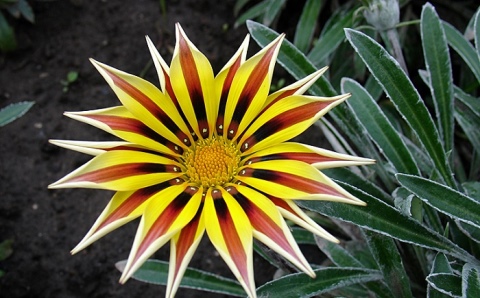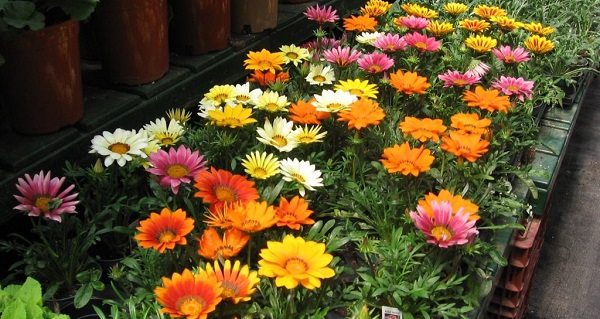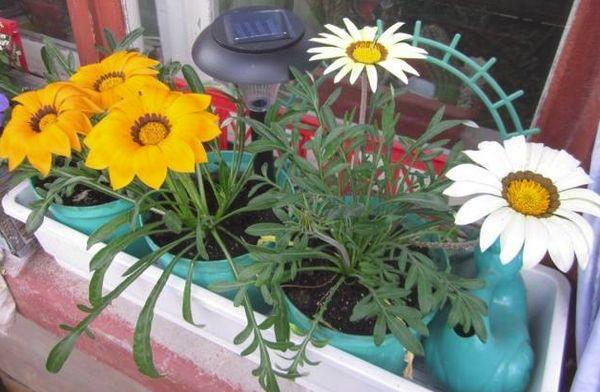Planting seeds and growing gatsania outdoors
Planting seeds and caring for an adult gatsania is not difficult. In this case, it is better to use new hybrid varieties that have not only a variety of colors, but also striped and spotted petals, which make them even more attractive. In addition, hybrid gatsania bloom longer and tolerate bad weather better. The flowers of this plant open up in the daytime, and when the sun goes down, its petals curl and close. The next morning they open up fully again. Breeders have developed a series of gats called Talent. Their petals are open at any time of the day or night.
Sowing seedlings, when to plant
We cultivate gatsania by seeds and vegetatively (cuttings). When sowing seeds in open ground, you need to be careful, as it often ends in vain. Therefore, we use the seedling method to grow flowers in our summer cottage. Having chosen the varieties we like, we sow the seeds in a peat-sandy substrate in January-early February. The soil for planting must be well moistened. Press the seeds into the substrate or lightly sprinkle them with soil. We water the earth and cover it with plastic wrap. The optimum temperature for quick emergence of shoots is 20-22 degrees. The first sprouts of gatsania break through after a week. We remove the film 2-3 days after germination. For good development of seedlings, the temperature is maintained at 16-18 degrees.
When the first 2 leaves appear, we dive the seedlings into peat pots. Plastic cups with a breathable substrate are also suitable for this. We water the seedlings only after the soil has dried. We feed young plants with complex fertilizers. We use additional lighting to grow strong seedlings. Flowering occurs 80-110 days after germination.
Transplanting seedlings
We plant seedlings in an open, well-drained summer cottage soil only after the air temperature has stabilized (when the frosts stop). Plants are placed with an interval of 15-25 cm. They look most advantageous when planted in a checkerboard pattern. When sowing seeds in February, gatsania will bloom in June. She will delight with an abundance of flowers until late autumn.
Propagation by cuttings
For vegetative propagation, we use rosette cuttings (stems with a heel from a lateral shoot), the length of which is 10 cm. We cut them with a sharp knife from well-developed bushes. Remove the lower leaves. We process the cut with "Kornevin". We plant gatsania cuttings in separate containers (cups) up to 10 cm in diameter, filled with a moistened nutrient substrate. We put plastic bags on them and place them in a warm, shaded place for rooting. After 5-6 weeks, they should take root. We plant grown and matured plants in flowerpots or open ground, when there is no threat of frost. We propagate gatsania terry varieties only vegetatively (by cuttings).
Gatsania care
Caring for this plant comes down to timely watering, weeding and loosening the soil. Gatsania is resistant to various diseases and is practically not damaged by pests.
Gating care can be mastered by any novice florist. We plant these warm and light-loving plants in open areas with good sunlight and loose sod-sandy soil. Since these flowers, unlike daisies, are considered undersized, we have only short "neighbors" next to them. Otherwise, gazania may lack adequate lighting, which will lead to a decrease in flowering intensity. We water it as the soil dries out. On dry days, we moisten the soil more often. We feed the plants twice a month throughout their growing season.
Autumn storage preparation
You can keep gating until next year.To do this, in the spring, we plant the seedlings in flowerpots, which we place in the right places of the summer cottage. Caring for such specimens is no different from the usual cultivation in flower beds. With the onset of autumn, we bring the flowerpots into the room. Also, if desired, you can save plants growing in flower beds.
In autumn (before frost) we carefully dig out the best specimens and transplant them into pots, being careful not to damage the taproot. We transfer the flowerpots with them to a cool room with an air temperature of 12-14 degrees
Cut off the tops of the flowers and water the soil when the soil dries. In the spring, we take out the flowerpots to the site, where the gatsania will again contribute to the landscape design and delight us with their beautiful leaves and luxurious flowers.
Reproduction of room gatsania
Growing from seeds remains the main breeding method even for indoor gating. Ready-made seedlings of this charming representative of the Astrov family appear on sale quite early. But growing it on its own is not difficult.
Gatsania is sown in April, in extreme cases - in early May. If possible, artificial supplementary lighting can be sown earlier.
Gatsania is grown in a standard way. Any universal substrate with a sufficient amount of sand for high water permeability is suitable for it. It is better to sow seeds on a leveled substrate and moisten them after sowing.
For gatsaniya, sowing is carried out not in common containers, but in small pots, individually, in rows, one seed at a time. A dive for this plant is not carried out.
Cover the seeds of this plant with soil more than 2 mm. Only after covering the soil is uniformly moistened with a finely dispersed spray gun.
Germinate gating under glass or film, at a temperature of 18 degrees Celsius, daily airing and removing condensation, slightly moistening the substrate when it dries.
Seedlings will have to wait long enough, but they develop quickly. The shelter is removed immediately, rearranging the crops to the brightest possible lighting and supplementing them on cloudy days.
Lowering the temperature below 15 degrees and using hard water is unacceptable. As the plants grow and the entire substrate is developed in containers, they dive into the main pots, carefully rolling over.
Gatsania preserved until spring can be used for separation. Dry leaves are removed from gatsania, and the bush is divided into separate outlets. They are planted, treated with growth stimulants and put on rooting in mild conditions with good lighting.
For any young gats, drafts, sudden temperature fluctuations and direct sun exposure to the shoots should not be allowed.
How to properly transplant gazani
If a plant is planted with seedlings, the latter are planted in open ground along with peat pots in which the seedlings grew. If the seedlings grew in a common flowerpot, each sprout is carefully removed, so as not to disturb the earth ball itself, encircling the root system, and planted in the dug holes. This method of transplanting is also typical for planting a flower overwintered bush in the ground.
The distance between the seedlings is at least 20 cm. But if the plant is grown by direct sowing of seeds - after its own, the grown seedlings are also planted at a similar distance between themselves.
Planting timing
Speaking about the optimal time for planting gazania, the optimal time is the end of May - the beginning of June, after there is no probability of the last spring frosts and the soil itself warms up. In the open ground, the plant itself is planted together with the pot, or by carefully removing the intact rhizome with the ground from the flowerpot, observing a distance of 15-20 cm.
The optimal place is an open, sunny area, with fertile soils, loose soil - here the plant will bloom until the first frost.
Site selection and soil preparation
Since hot Africa is the homeland of this sunny plant, this is precisely what determines the features of its planting, choice of location and care. By itself, gazania prefers illuminated areas that have loose soil, loose in texture and without excessive dampness and stagnant moisture.
The best option for the growth of gazania is loose soils, non-clayey, light and nutritious, rich in nutrients, with excellent drainage and the pH of which ranges from 5.5–6.5. Speaking of planting seedlings, it is worth choosing a sod-compost mixture for this, which is made from rotted foliage, turf, peat and sand, as well as humus.
Soil processing and preparation
In order for gazania itself to feel comfortable in the open field, the soil should be properly cultivated both before planting and during its growth. In this case, timely loosening, as well as removal of weeds and wilted inflorescences, as well as mulching - it is the latter that helps to retain moisture in the soil, without stagnation during drought and heavy rains, and will also be a kind of obstacle for weed growth.

Open ground planting process
The plant is planted in open ground in a permanent place in an open area only after the spring frosts have passed and the ground has warmed up. A few days before planting the seedlings, it is worth putting the seedlings or flowerpots with the plant on the street, leaving it overnight, plus you should not water the gassing - this will minimize the injury to the root system of the plant during transplantation.
After planting the gazani in open ground, the plant should be watered very abundantly with water and then sprinkled with dry sand on top. After 2 weeks after planting in open ground, the plant needs feeding - in this regard, it is worth using mineral fertilizers. With normal growth of gazania, it is worth feeding it once every 3-4 weeks, alternating mineral and organic fertilizers.
In order for the gazania itself to constantly grow and bloom, it should be removed during the flowering process of each inflorescence. And from the middle of summer, you can plant the bushes themselves by cuttings - in this case, it is worth separating several lateral processes and branches from gazania and putting them in water with any growth stimulant. After the first shoots of the roots appear, the leaves can be planted in an area where there is no draft and direct, scorching sun.
Conditions for growing indoor gats
The conditions and care should be the same for purely indoor gats, which bloom for an amazingly long time and, with the right approach, can please even in winter, and for garden and room gats, which move into rooms only with the arrival of the first frost.
Lighting and temperatures are the keys to growing this plant in an indoor format. If it is not possible to expose gating in bright light and provide additional lighting or movement on cloudy days, you will not succeed.
Despite the fact that the idea to grow gatsania in a purely indoor format appeared due to the desire to preserve it for the winter where frosts are too severe for African chamomile, indoor gatsania are divided into two groups:
- true indoor plants, which were originally grown for the interior;
- garden-room, which are transferred to the premises in the fall to preserve or extend flowering.
The care of these two types of indoor gating should be the same, as well as the growing conditions for this crop.
Lighting and placement
And so it is light-loving in itself, in a room format gatsaniya simply will not be able to grow and bloom normally even in light partial shade. Only window sills are suitable for her - and the brighter they are, the better.
South windows and light balconies are the only option for indoor gating and for plants that move into rooms from the garden
With the onset of autumn, in order to continue the flowering of indoor gats, which were originally grown in a potted form, it is important to respond in a timely manner to changes in lighting.
On cloudy days, blooming gatsania illuminate. The same should be done with plants that have been transferred from the garden to bloom for the winter.
Gatsanias look great on windowsills in the kitchen, where you can admire enough plants. They seem to be created to decorate the corners of needlework and children's rooms. Their beautiful baskets fit perfectly into dining rooms and balconies.
Gatsanias can be grown not only as single bushes in separate pots, but also planted in the same containers with other herbaceous plants.
Temperature control and ventilation
Gatsania are so thermophilic that they are comfortable only in temperatures exceeding 20 degrees Celsius. The room regime is quite suitable for them, but these unique plants are not afraid of the heat either.
If the temperature readings exceed 25 degrees, gazaniya become more demanding for fresh air access. Wintering gatsanii is a relative concept. The plant is most often simply thrown away when flowering is complete. But if you create the right conditions, it does not stop at all in late summer and early autumn, but can cover the whole winter.
The air temperature for continuing flowering gats should not fall below 10 degrees Celsius, but an increase above 15 degrees is undesirable. The coolness prolongs flowering for a longer period.
Gatsanias that are left in pots can be displayed on balconies or taken out into the garden, if possible. They love fresh air and do not grow without normal air circulation around the bushes. In the heat, only fresh air compensates for the uncomfortable conditions in the premises.
A unique feature of the gatsan is its resistance to drafts and winds. This plant is able to be content with any conditions, is not afraid even of open balconies at high altitudes, which, of course, is a huge advantage along with their heat resistance.
 Gatsania harsh (Gazania rigens). Al
Gatsania harsh (Gazania rigens). Al
Caring for Gatsania in the garden
Caring for Gatsania is not much different from caring for other flowering plants.
However, there are some nuances that need to be taken into account.
Temperature regime
Gatsania is thermophilic, tolerating drought calmly. But at the same time, she can survive a decrease in temperature to -5 ° C, so that the first autumn frosts will not do much harm to her.
Watering
Watering Gatsania is necessary in moderation, since waterlogging of the soil can cause the development of fungal diseases. After watering, it is recommended to loosen the area, weed it out. It is recommended to mulch the soil to retain moisture. In addition, mulch will prevent weeds from germinating.
Top dressing
For long and abundant flowering of Gatsania, regular feeding is necessary. If the soil is rich in nutrients, then fertilizers are applied once every 1-1.5 months, and if the soil is poor, then Gatsania is fed at intervals of 13-15 days. As a top dressing, a complex mineral fertilizer should be used. For 1 square meter of the site, approximately 20-25 grams of fertilizer will be required.
Flowering care
The life span of a flower basket is about 3 weeks. In the dark, as well as on a cloudy day, the reed flowers roll up, covering the yellow core, which consists of tubular flowers.
If the plant does not bloom well or has no flowers at all, you need to look for the reason. This may be a lack of lighting, waterlogging of the soil, or the seedlings were late planted in the ground.
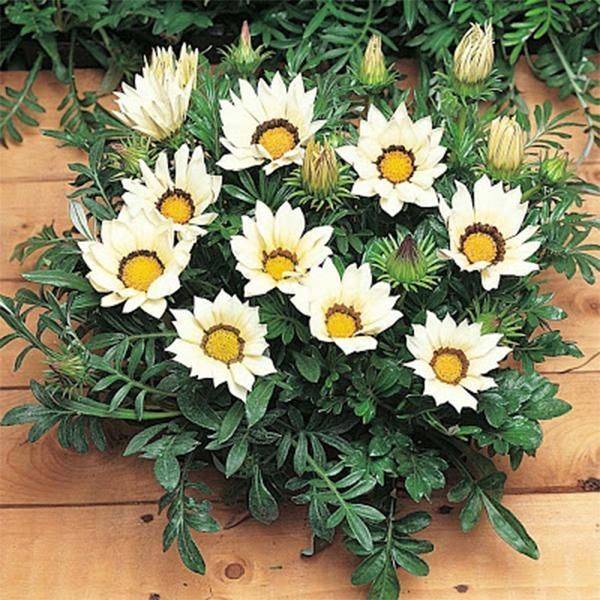
Gatsania Talent white
Seed collection
In temperate climates, it is not always possible to wait for the seeds to fully ripen. This can only happen if the summer has been hot, dry and long. In addition, it should be borne in mind that hybrid varieties of Gatsania are grown as a crop, and their seeds do not retain the varietal characteristics of the parent plant.
Another nuance: the ripe inflorescences of Gatsania are somewhat reminiscent of Dandelion, with a strong gust of wind, the seeds simply fly away.
If you nevertheless decided to collect the seeds, then in order for them not to scatter, it is necessary to wrap the fading inflorescences-baskets with gauze, fix it on the peduncle. The seeds, crumbling, will remain in the gauze.
Preparation for wintering
If an annual Gatsania is grown in the garden, then in the fall, after flowering is complete, the bushes are removed from the soil and burned, especially if they are infected with rot. If the bush is healthy, then it can be saved for the next year. To do this, the most liked specimens are dug up and transplanted into containers, which are transferred to a bright but cool room (the optimum temperature is from + 8 ° C to + 10 ° C). It is necessary to water the plants rarely, rather in moderation, but do not allow the earthy clod to dry out too much. In the spring, the bushes are again planted in open ground, while shortening their shoots by ½ of their length.
Diseases. Pests
Gatsania is a plant that is highly immune to various diseases. However, under unfavorable conditions, for example, with prolonged damp weather, waterlogged soil, the plant can be affected by gray rot. It is not realistic to save diseased bushes. They must be dug up, burned, and the place where they grew must be treated with a fungicidal solution.
The danger to the plant is carried by snails, spider mites, aphids. If snails can be collected by hand, then sucking harmful insects must be fought with insecticides, for example, Aktelik, Ditox, Inta-Vir or Fitoverm.
Features of growing seedlings
Since the flowers grown are medium-sized seeds, it is recommended to plant in such a way that you do not have to dive later. The container should be taken deep. Peat cups are ideal. The container will need to be covered with planting soil (in order to grow a strong bush, it is better to take ready-made universal soil).
Seeds need to be staggered. The optimal distance from each other will be 3 cm. If you sow thicker, and they all germinate, then remove the weak plants, leaving healthy and strong seedlings. From above, the seeds are covered with a small layer of soil and moistened with warm water using a spray bottle.
Be sure to put glass or film on top, which allows you to create a greenhouse effect
When growing gatsaniya using this technology, it is important not to forget to air the seedlings every day. The soil is moistened as it dries
After the emergence of seedlings, the shelter must be removed completely, but gradually, every day, the time of the seedlings staying without it is increased.
If an insufficiently deep container was used for planting the seeds, the seedlings will need to be replanted due to the fact that the gatzania has an elongated root system. You can dive after the emergence of four true leaves on the shoots. After that, African chamomile should be kept in a cool place.
The optimum temperature for the plant is 15 ° C. In the case of growing seedlings in an apartment, after diving, it can be displayed on a glazed loggia. After 2-3 days, gating is taught to the open air.
To do this, open the window for a short time every day, but it is important not to create a draft. So, the plant will harden and will be ready for transplanting into open soil.
Seedling care
To prevent decay, the containers are ventilated daily. When all the seedlings have risen, remove the weak shoots. If planted often, despite the recommendations, it is better to cut off the stems with nail scissors so as not to damage the roots. Moisturize as it dries, from a spray bottle.
The plant is drought tolerant. When the Moon is in the sign of Gemini, Libra and Aquarius, it is advisable to refrain from moisturizing. According to folklore, watering these days will lead to an invasion of herbal fleas. As soon as half of the seeds have sprouted, the seedlings begin to harden.First, the coating is removed for 3 hours a day, then the time is gradually increased. After 2-2.5 weeks, the "greenhouse" is dismantled.
A pick is needed not only for frequent planting, but also if you have chosen a not very deep container. In this case, 4 permanent sheets are waiting. After pinching the root system, the temperature regime is changed - at night + 15 ° C is enough. After another 3 days, hardening begins.
When growing a house, containers are briefly installed on the windowsill, the window is opened, avoiding drafts. After 2 weeks, you can already take it out to the glazed loggia and carry out the first top dressing - with a solution of liquid organic matter or ready-made mineral fertilizers. Outdoor hardening begins at an average daily temperature of + 5 ° C. The containers are placed in partial shade - at this stage they must be protected from direct sunlight.
The use of gatsania in landscape design
In Africa, gatsania is grown as a perennial, but in European regions it does not survive the cold winter and is grown as an annual plant. Suitable for almost all types of climates, but in cold latitudes, it should be dug up in autumn. The plant does not like waterlogging and a large amount of precipitation. Stably tolerates temperature fluctuations from -5 ° C to 35 ° C, with severe frosts it immediately dies.

Gazania in landscape design
Gatsania - an annual or perennial - can be grown in containers and flower pots to decorate balconies and terraces. Suitable for placement in flower beds, in flower beds, along paths in the garden, on alpine slides.
Note! It is allowed to grow African chamomile as a home plant. In the design of a flower garden, Iberis, Venidium, Lobelia can become her ideal neighbors.
Avoid planting near too tall plants that will block access to light, such as verbena or delphinium. In the form of a cut, gazania lasts for about 8-9 days
In the design of a flower garden, Iberis, Venidium, Lobelia can become its ideal neighbors. Avoid planting near too tall plants that will block access to light, such as verbena or delphinium. In the form of a cut, gazania lasts about 8-9 days.
Hybrid plant varieties, among which harsh gazania and long-shot gazania are most often found, are grown as annuals. They can reach 30 cm in height, bloom profusely from mid-summer until the onset of cold weather. These varieties are distinguished by multi-colored reed petals, making them of particular interest to gardeners. Suitable for creating contrasting colorful mixes, bloom earlier and are more resistant to adverse weather.
There are also many other varieties, including peacock gazania, feathery, one-flowered. Peacock gazania has about 20 cm long leaves, covered with harsh hairs on top, juicy orange flowers with a yellow center and a black ring around it. The feathery gazania has a pinnately dissected leaf shape and orange flowers with a dark mark towards the middle. The single-flowered variety is a compact plant with creeping stems and pale yellow baskets of numerous medium-sized flowers.

Different types of gazania
2 Plant species
To date, about forty species of gatsania are known. Several of them are grown as cultivated ornamental plants:
- 1. Gazania is brilliant. For gatsania brilliant (Gazania splendens), a rosette is characteristic, consisting of shiny, narrow, solid or feathery foliage of a dark green color. Its length reaches from ten to fifteen centimeters. A well-formed plant produces up to ten bright, large inflorescences, six to eight centimeters in diameter. They are located on the tops of strong peduncles from ten to twenty centimeters high. The inflorescences consist of bright orange reed flowers, which may have cream, brown or black specks located closer to the middle.The color of tubular flowers can be yellow or purple. Gazania blooms brilliantly from July to early September.
- 2. Gatsania is snow-white. Gatsania snow-white (Gаzania nivea) is a compact rosette plant with a short lignified stem and fairly strong peduncles. The foliage has an entire or pinnately dissected shape and dense pubescence of white hairs. In this regard, the plant seems snow-white.
- 3. Gatsania is one-flowered. Gatsania single-flowered (Gazania unifiora) is a plant that reaches a height of ten to fifteen centimeters. The rosette consists of long foliage with a smooth outer surface, the inner one has white pubescence. The diameter of the inflorescences reaches five centimeters, the color of the reed petals is golden yellow with spots of various colors. The stems of the plant creep, therefore, during flowering, areas with single-flowered gatsania plantings look like dense carpets.
- 4. Gatsania plumose. Gatsania pinnata (Gazania pinnata) reaches a height of no more than twenty centimeters. Long foliage has a lobed or pinnately dissected shape. The reed flowers of the inflorescences are orange in color, and the tubular flowers are usually dark.
- 5. Long rifle gatsania. Gatsania long-shot (Gazania longiscara) is a plant from fifteen to twenty centimeters high with creeping stems. Its foliage can be whole or slightly dissected. Its upper side is bright green, and the lower side is white pubescent. The diameter of the inflorescences reaches seven centimeters, the color of the reed petals is golden yellow with brown spots at the base. The middle, consisting of tubular flowers, is bright yellow. Long-rifle gatsania bloom begins in August.
- 6. Gatsaniya peacock. Gatsania peacock (Gazania pavonia) is characterized by a very short stem and narrow bright green foliage about twenty centimeters in length. Its shape can be solid or slightly cut. The diameter of the inflorescences can be more than eight centimeters. The color of the ligulate flowers is bright orange with black spots at the base, and in the tubular flowers it is yellow. Flowering lasts from mid-July to early autumn.

Possible problems
Gazania, despite the low requirements for regular care, can hardly be called a problem-free plant. Most of the difficulties relate to the lack of flowering, problems with the wintering of these flowers or the appearance of pests.
- Lack of flowering. Unfortunately, in this case, the problem is rather complex and concerns a number of factors that can affect the number of buds or their absence. Among the most common reasons are: the choice of a late-flowering variety; incorrect planting dates, which is why the plant simply does not have time to bloom before frost; insufficient lighting, which directly affects the abundance and saturation of the buds; feeding with nitrogen fertilizers, which stimulate the development of the shoots of the flower, and not the buds.
- Wintering. Inexperienced gardeners, when buying gatsania, are content with the knowledge that it is a perennial plant, and therefore can tolerate wintering. Unfortunately, it is this garden culture that in most cases needs home storage in order to survive the cold. Everything is explained by the warm homeland of this horticultural culture, where it can grow in peace all year long. Before buying a certain type of gazania, ask if it is frost-resistant.
- Diseases and pests. If we talk about diseases, then gazania is most often exposed to gray rot or black legs. These are fungal diseases that appear from excess moisture or can be introduced into the soil before the seedlings are planted. Antifungal drugs and fungicides will help against these diseases. Among the pests on gatsania, you can sometimes find aphids or spider mites. Aphids can be removed by hand and the bush can be poured with warm water, but ticks must be fought with insecticides.
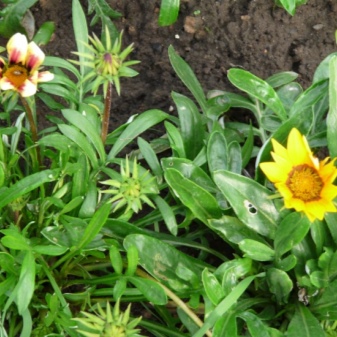
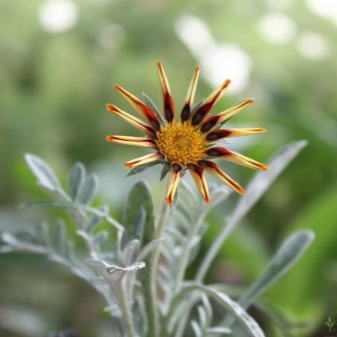
Planting and caring for gazania in the next video.
Types and varieties of indoor gats
Several species of gazanii are grown in the gardens, although less diverse and original wild or native African species have almost completely supplanted hybrid varieties.
But as a full-fledged indoor and container plant, only hybrid gatzania (Gazania x hybrida, or Gazania Hybrids) is considered. These are compact varieties up to 30 cm in height with linear or finger-dissected leaves, most often with a reverse silvery edge and inflorescences up to 8 cm in diameter, blooming in mid-summer.
The variety of varieties of this versatile plant, represented mainly by ultra-hardy hybrids, allows you to make a choice purely according to personal tastes. Gatsania are chosen according to the color of the inflorescences - the degree of variegation, shades, the size of the baskets.
If you want to keep gatsania as a perennial, you can also transfer plants of other species to the rooms:
- Gazania linearis is a beautiful creeping species with whole, bright leaves with a white edge on the back and golden brown baskets that bloom only in August.
- Gatsania rigens (Gazania rigens) is a beautiful perennial with short shoots, dense incised leaves and medium yellow-orange baskets, reminiscent of the sun and appearing on the bushes in June.
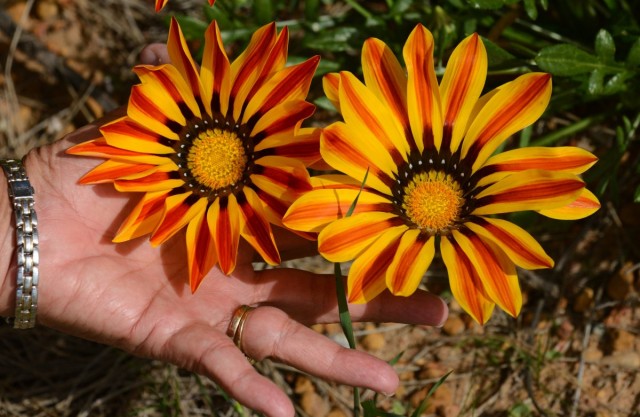 Gazania linear (Gazania linearis). azrocklady
Gazania linear (Gazania linearis). azrocklady


